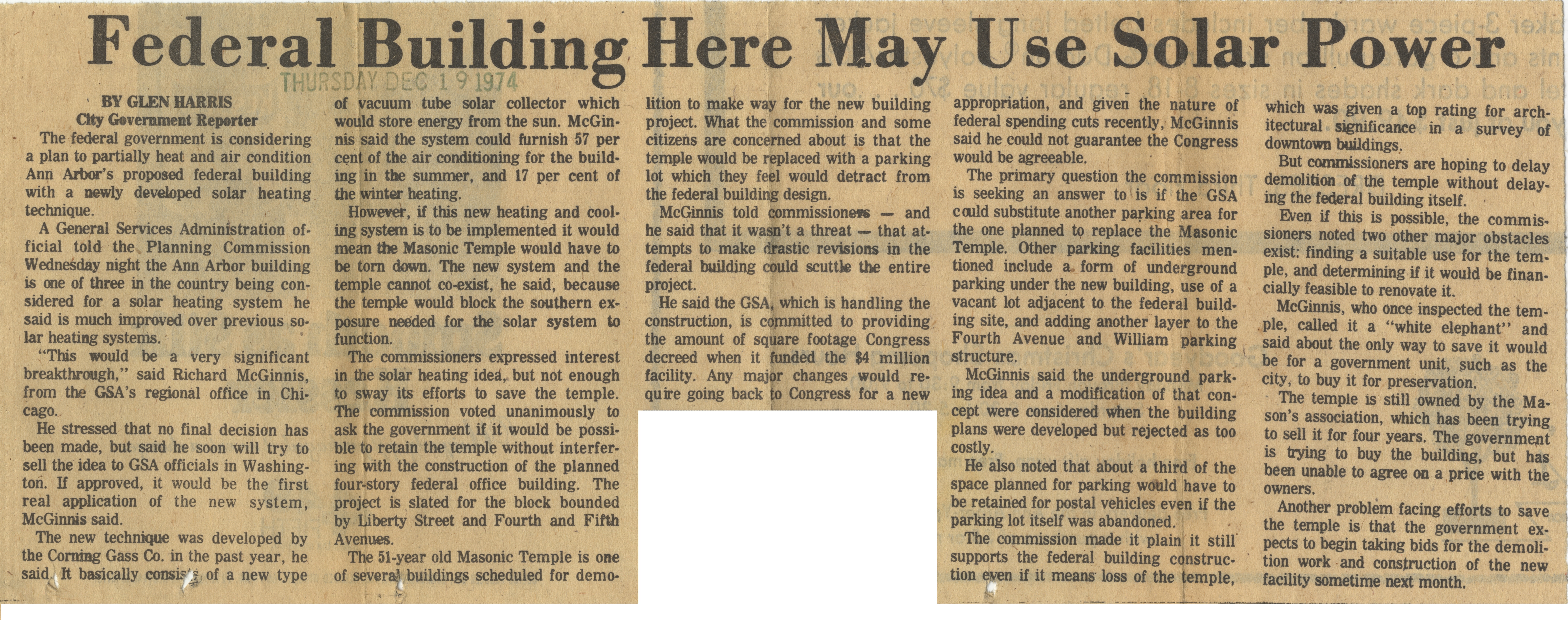Federal Building Here May Use Solar Power

Federal Building Here May Use Solar Power
By Glen Harris
City Government Reporter
The federal government is considering
a plan to partially heat and air condition
Ann Arbor's proposed federal building
with a newly developed solar heating
technique.
A General Services Administration of-
ficial told the. Planning Commission
Wednesday night the Ann Arbor building
is one of three in the country being con-
sidered for a s 'ting system he
said is much mi, iver previous so-
i lar heating systems.
"This would be a very significant
breakthrough," said Richard McGinnis,
from the GSA's regional office in Chi-
cago.
He st--—'--1 that no final decision has
been n i said he soon will try to
sell the idea to GSA officials in Washing-
ton. If approved, it would be the first
real application of the new system,
McGinms said.
T nique was developed by
the ^.tuuo -"*ss Co. in the past year, he
said R basically consif'J; of a new type
of vacuu'ii ;' '•w ' " ', . vhich
would st" i.^Gin-
nts F in could furnish 57 per
cent < nditioning for the build'
ing in the summer, and 17 per cent of
the winter heating.
However, if this new heating and cool-
ing system is to be implemented it would
mean the Masonic Temple would have to
be torn down. The new system and the
temple cannot co-exist, he said, because
the temple would block the southern ex-
posure needed for the solar system to
function.
The commissioners expressed interest
in the solar heating idea, bu >ugh
to sway its efforts to save Ihc lemple.
The commission voted unanimously to
ask the government if it wouk' ' e ",oasi.
ble to retain the temple with-..,,
ing with '!' struction of the planned
four-story ! office building. The
project is slated for the block bounded
by Liberty Street and Fourth and Fifth
Avenues.
The 51-year old Masonic Temple is one
of severa? buildings scheduled for demo-
lition to make way fw f^'1 »' '^ ng
project. What the co> ne
citizens are concerned about is that the
temple would be replaced with a parking
lot which they feel would detract from
the federal building design.
McGinnis told commissionew — and
he said that it wasn't a threat — that at-
tempts to make drastic revisions in the
federal building could scuttle the entire
project.
" 'he GSA, which is handling the
in, is committed to providing
the amount of square foe ngress
decreed when it funded l..- ,.. million
facility. Any major changes would re-
quire going back to Congress for a new
appropriation, and given ^i rri-e of
federal spending cuts rer nnis
said he could r" ! "" "-• ress
would be agreeai'K
The primary question the commission
is seeking an answer to is if the GSA
could substitute another parking area for
the one planned to replace the Masonic
Temple. Other parking facilities men-
tioned include a form of underground
parking under the new building, use of a
vacant lot adjacent to the federal build-
ing site, and adding another layer to the
Fourth Avenue and William parking
structure.
McGinnis said the underground park-
ing idea and a modification of that con-
cept were considered when the building
plans were developed but rejected as tpo
costly.
He also noted that about a third of the
space planned for parking would have to
be retained for postal vehicles even if the
parking lot itself was abandoned.
The commission made it plain it still
supports the federal buildinr -i"-*—"
tion even if it means loss of
which v - n a top rating for arch-
itecture seance in a survey of
downtov rigs.
But caaaa^iaiOners are hoping to delay
demolition of the temple without delay-
ing the federal building '' '"
Even if this is pos& ,s-
sioners noted two other major obstacles
exist: finding a suitable use for the tem-
ple, and ning if it would be finan-
cially fea-i! •' renovate it.
McGinnis, who once inspected the tem-
ple, called it a "white elephant" and
said about the only way to save it would
be for a government unit, such as the
city, to buy it for preservation.
The temple is still owned by the Ma-
son's association, which has been trying
to sell it for four years. The government
is trying to buy the building, but has
been unable to agree on a price with the
owners.
Another problem facing efforts to save
the temple is that the government ex-
pects to begin taking bids for the demoli-
tion work and construction of the new
,-*cility sometime next month.
Article
Subjects
Glen Harris
William Street Parking Structure
United States Government - General Services Administration
Solar Energy
Real Estate
Parking
Masonic Temple
Historic Buildings
Heating Cooling and Air Conditioning
Fourth Avenue Parking Structure
Federal Building - Ann Arbor
Demolitions
Corning Glass Co.
Building & Construction
Architecture
Ann Arbor City Planning Commission
Ann Arbor News
Old News
Richard McGinnis